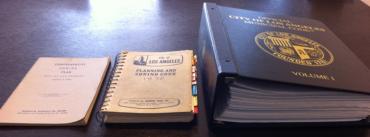The city of Los Angeles Department of City Planning is hosting a series of seven community planning forums running now through April 12th. Tonight's forum is at Metro HQ in Downtown L.A. from 5-8pm. The forums are for public feedback on three citywide planning processes: re:code L.A., Mobility Plan 2035, and Plan for a Healthy Los Angeles. Streetsblog is previewing the citywide initiatives; today it’s the city’s zoning code update. See earlier SBLA coverage of the Health Plan and Transportation Plan.

L.A.'s Department of City Planning (DCP) has been busy with three initiatives that have the potential to shape livability for many years to come. The three plans are for health, transportation, and, well, something that just doesn't lend itself to a jargon-free soundbite: modernizing the zoning code.
Zoning code is the city's set of rules that mostly determine what can be built, where it can be built, and how it's used. It specifies various aspects of development from how tall a building can be, how much signage is allowed, what industries are allowed in what areas, and how much off-street parking is required.
Here is a sample from the current zoning code:
Off-Street Automobile Parking Requirements. A garage or an off-street automobile parking area shall be provided in connection with and at the time of the erection of each of the buildings or structures hereinafter specified, or at the time such buildings or structures are altered, enlarged, converted or increased in capacity by the addition of dwelling units, guest rooms, beds for institutions, floor area or seating capacity. The parking space capacity required in said garage or parking area shall be determined by the amount of dwelling units, guest rooms, beds for institutions, floor area or seats so provided, and said garage or parking area shall be maintained thereafter in connection with such buildings or structures.
The new zoning code effort goes by its nickname re:code LA, billed as "A New Zoning Code for a 21st Century Los Angeles." Of the three citywide initiatives, re:code arguably the least comprehensible to the general public and the least far along. The re:code project started in 2013 and is expected to be completed in 2017.
From this early in the process, the final results aren't entirely clear, but a lot of re-code work appears to be neutral; it's mostly re-writing and re-organizing rules that are already in place. Generally, the re-write doesn't change policy. If you work in an commercial area, re:code won't change it into a residential area. Zoning has been established for every part of Los Angeles, and re:code generally won't be changing what's approved. It will add new options that can take effect later. The format will change, too. Instead of a paper pamphlet, it will be a whizbang contemporary user-friendly web-based document.
For example, if a neighborhood has too many liquor stores, the new code won't change the number of liquor stores allowed, but may provide streamlined rules that could help limit future liquor stores. Generally, that streamlined rule wouldn't go into effect when re:code is adopted in 2017, but would become available to be later added to local planning documents - community plans, specific plans, etc. So, don't expect to see any re:code changes affecting your street any time soon.
So far, DCP and their consultants have begun the process by listening to the public and the experts and creating a Zoning Code Evaluation Report. The report is more of a description of the scope of work for the future of re:code, with an outline of possibilities for actual changes that may be ahead.
The report includes a few aspects of re:code that may be especially interesting to Streetsblog readers:
1. New zoning code for Downtown Los Angeles: Because downtown is more population-dense, more transit-rich and more built-out than most parts of Los Angeles, it's getting its very own zoning code. It's too difficult to apply the same set of rules to downtown as are applied to, say, Porter Ranch. Downtown's new zoning is anticipated to include expanding adaptive reuse, facilitating transfer of development rights, and generating more affordable housing.
2. New zoning around transit stations: Somewhat similar to the downtown zoning, re:code is proposing a new set of rules for development around rail and BRT stations. The new Transit Oriented Development (TOD) zoning is expected to emphasize walkability, including fostering a diverse mix of uses.
3. New parking regulations: The pseudo-science behind parking requirements fills quite a few chapters of Shoup's The High Cost of Free Parking. Nonetheless, the existing zoning code's parking requirements continue to exert a huge negative impact on urban form and livability. Re:code proposes to "rightsize" parking requirements, through the use of features including: off-site parking, shared parking, un-bundling parking from housing, and "re-evaluating" those pseudo-scientific parking ratios.
These possibilities sound good, but right now they're just possibilities suggested in the Zoning Code Evaluation Report. They may be available in 2017... but even then, they generally won't take effect until they're adopted through a subsequent multi-year planning process.
To learn more about re:code LA, attend a planning forum or visit the project website. Streetsblog L.A. will continue to track and report on re:code as it takes shape.






